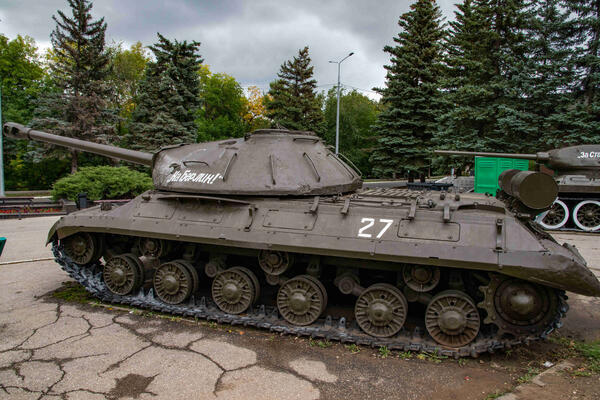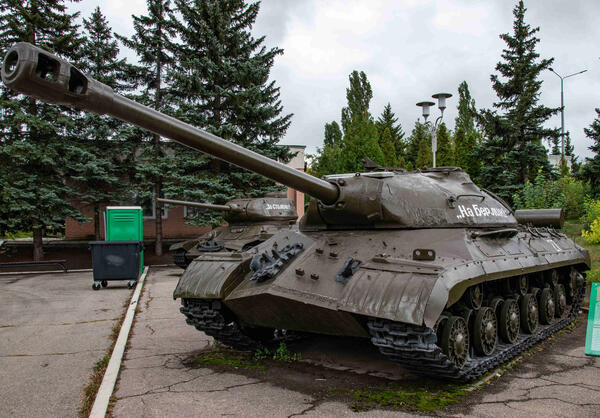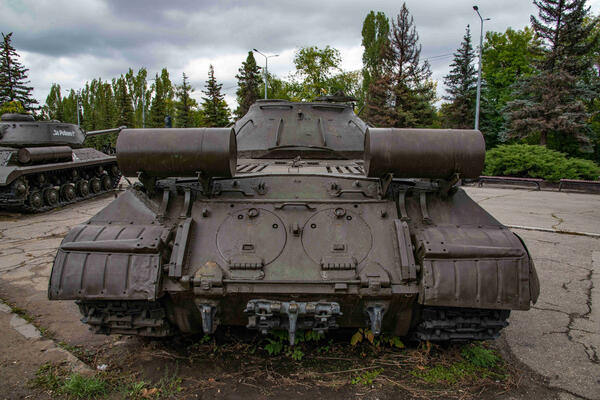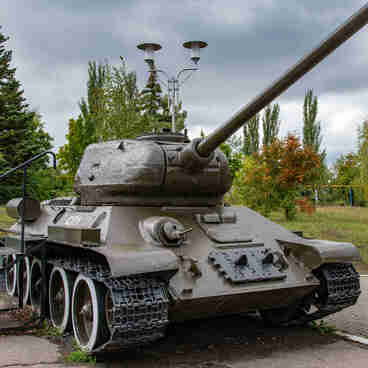The IS-3 heavy tank was developed on the basis of the IS-2 tank at the Kirov Plant No. 178 in Chelyabinsk under the leadership of Mikhail Fyodorovich Balzhi. It entered service in 1945. The new tank model differed from its predecessor in improved armor protection.
In addition, the tank was fitted with a new cast turret of a flattened spherical shape with an armor thickness of up to 250 mm. The plates of the frontal armor were positioned so that the front part of the tank was three-pitched, cone-shaped, and forward-elongated. Because of its peculiar shape, it was nicknamed “pike nose”. The driver’s hatch was placed in the roof. There was no vision port for the driver-mechanic in the frontal armor, it was replaced by periscopic devices.
The armament of the IS-3 tank consisted of a 122mm D-25T tank gun M1943 with a barrel length of 48 calibers and a coaxial 7.62mm DT machine gun. They were mounted on trunnions in the frontal part of the turret and installed in a cast mantlet of the turret with a thickness of 250 mm. It was also fitted with a 12.7mm ring-mounted large-caliber DShK machine gun.
The gun had a semi-automatic mechanical horizontal sliding breechblock, electromagnetic and mechanical safety mechanisms and a two-chamber muzzle brake. The gun’s effective rate of fire was up to three rounds per minute.
The ammunition of the gun consisted of 28 separate-loading rounds: 18 high-explosive fragmentation and 10 armor-piercing blunt- and sharp-nose shells. The IS-3 was the last tank that was developed during the Great Patriotic War, but it was not used in combat operations.
The first experimental batch of IS-3 heavy tanks left the factory workshops in May 1945. Before production was stopped in mid-1946, 2311 units were manufactured with 29 units made before the end of the Great Patriotic War.
The IS-3s entered service with heavy tank self-propelled regiments of the Soviet Army, where they were in service until the 1970s. The revolutionary, for its time, configuration of the hull and turret had a huge impact on the post-war peacetime tank building.
Design flaws negatively affected the combat capabilities of the tank. Despite the implementation of two modernization programs, it was not possible to eliminate them completely.
In addition, the tank was fitted with a new cast turret of a flattened spherical shape with an armor thickness of up to 250 mm. The plates of the frontal armor were positioned so that the front part of the tank was three-pitched, cone-shaped, and forward-elongated. Because of its peculiar shape, it was nicknamed “pike nose”. The driver’s hatch was placed in the roof. There was no vision port for the driver-mechanic in the frontal armor, it was replaced by periscopic devices.
The armament of the IS-3 tank consisted of a 122mm D-25T tank gun M1943 with a barrel length of 48 calibers and a coaxial 7.62mm DT machine gun. They were mounted on trunnions in the frontal part of the turret and installed in a cast mantlet of the turret with a thickness of 250 mm. It was also fitted with a 12.7mm ring-mounted large-caliber DShK machine gun.
The gun had a semi-automatic mechanical horizontal sliding breechblock, electromagnetic and mechanical safety mechanisms and a two-chamber muzzle brake. The gun’s effective rate of fire was up to three rounds per minute.
The ammunition of the gun consisted of 28 separate-loading rounds: 18 high-explosive fragmentation and 10 armor-piercing blunt- and sharp-nose shells. The IS-3 was the last tank that was developed during the Great Patriotic War, but it was not used in combat operations.
The first experimental batch of IS-3 heavy tanks left the factory workshops in May 1945. Before production was stopped in mid-1946, 2311 units were manufactured with 29 units made before the end of the Great Patriotic War.
The IS-3s entered service with heavy tank self-propelled regiments of the Soviet Army, where they were in service until the 1970s. The revolutionary, for its time, configuration of the hull and turret had a huge impact on the post-war peacetime tank building.
Design flaws negatively affected the combat capabilities of the tank. Despite the implementation of two modernization programs, it was not possible to eliminate them completely.





